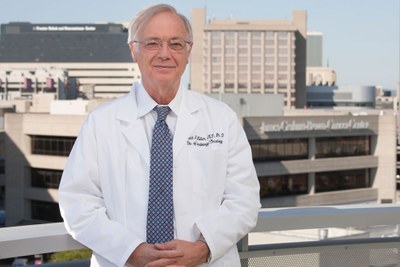Donald M Miller, M.D., Ph.D.
Education:
B.S., Chemistry and Biology, Florida State University, 1967
Ph.D., Biochemistry, Duke University, Durham, N.C., 1973
M.D., Duke University, Durham, N.C., 1973
Internship and Residency, Internal Medicine, Peter Bent Brigham, Boston, MA, 1973-1975
Clinical Associate, NHLBI, National Institutes of Health, Bethesda, MD, 1975-1978
Senior Staff Associate, NCI, National Institutes of Health, Bethesda, MD 1978-1979
Curriculum Vitae
Current Positions:
Professor of Medicine, Director of Medical Oncology
Brown Chair of Oncology
Director, Brown Cancer Center
Associate Vice President of Health Affairs
Director, University of Louisville M.D./Ph.D. Program
Board of Directors and Founder, Advanced Cancer Therapeutics
Contact Information:
Brown Cancer Center
University of Louisville
529 S. Jackson St.
Louisville, KY 40202, USA
Phone 502-562-4790
Fax 502-562-4368
Email: donaldmi@ulh.org
Research Description:
Dr. Miller’s group is interested in gene-targeted therapeutics. We were the first to observe, in the early eighties that DNA binding drugs inhibit the expression of important genes in cancer cells. We were able to document sequence-specific binding of “triplex-forming” oligonucleotides to the promoters of the c-Myc, kRAS, DHFR genes, among others. In 1997, Paula Bates discovered the growth inhibitory activity of a four stranded oligonucleotide, AS1411, in a wide variety of tumor types. Dr. Bates, Dr. John Trent and Dr. Miller founded Aptamera, a Louisville biotech company to develop AS1411 in a phase I clinical trial. This was the first DNA aptamer to be tested in cancer patients and demonstrated significant clinical activity with very little toxicity.
Subsequent work has focused on the growth inhibitory of quadruplex-forming oligonucleotides which encode genomic sequences from promoters of the c-Myc, KRAS, VEGF, and telomerase genes, among others. We have shown that these stable oligonucleotides interact in a sequence-specific manner with their corresponding sequence in cells and inhibit expression of their target genes in transformed cells. These oligonucleotides are currently in preclinical development by the Louisville biotech company, Advanced Cancer Therapeutics.
As Director of the Cancer Center, Dr. Miller has been actively involved with the development of the Owensboro Cancer Research Program, a partnership between the Brown Cancer Center and the Owensboro Health System. This program, Directed by Kenneth Palmer, Ph.D., has developed three “plant-made” vaccines which are expressed in tobacco and are currently in preclinical development. We anticipate that these three agents will be tested in humans within the next two years.
Literature Cited:
- Miller DM, Turner P, Gopalakrishanan TK, Nienhuis AW, Axelrod D. Active conformation of the globin genes in uninduced and induced mouse erythroleukemia cells. Cell 14:511-22, 1978
- Koller CA, Campbell VW, Yang A, Mulhern A, Miller DM. Expression of c-myc and c-abl proto-oncogenes during in vivo differentiation of blast phase chronic granulocytic leukemia. J Clin Invest 76:365-9, 1985
- Koller, C., Miller, D.: Preliminary observations on the therapy of the myeloid blast phase of chronic granulocytic leukemia with plicamycin and hydroxyurea. NEJM 315:1433-1438, 1986.
- Snyder, R.C., Ray, R., Sanchez, J.D., Blume, S., Koller, C.A., Miller, D.M.: Mithramycin blocks transcriptional initiation of the c-myc P1 and P2 promoters. Biochemistry, 30:4290-4297,1991.
- Gee, J., Ray, R., Snyder, R., Blume, S., Miller, D.M.: Triplex formation prevents Sp1 binding to the dihydrofolate reductase promoter. J. Biol. Chem., 267(16), 11163-11167, 1992.
- Reddoch, J., Miller, D.M.: Inhibition of nuclear protein binding to two sites in the murine c-myc promoter by intermolecular triplex formation. Biochemistry, 34:7659-7667, 1995.
- Kim, H., Reddoch, J.F., Mayfield, C., Ebinghaus, S., Vigneswaran, N., Thomas, S., Miller, D.M.: Inhibition of Transcription of the Human c-myc Proto-oncogene by Intermolecular Triplex. Biochemistry, 37:2299-2304, 1998.
- Schwartzentruber DJ, Lawson D, Richards J, Conry RM, Miller DM, Treisman J, Gailani F, Riley L, Conlon K, Bockaj B, Kendra K, White RL, Gonzalez R, Kuzel T, Curti B, Leming P, Whitman E, Balkisson J, Reintgen D, Kaufman H, Marincola F, Merino M, Choyke P, Vena D, Hwu P. A phase III multi-institutional randomized study of immunization with gp100:209-217(210M) peptide followed by high dose IL-2 vs. IL-2 alone in patients with metastatic melanoma. N Engl J Med., 2011;364(22):2119-27. Bates, P.J., Kahlon, J.B., Thomas, S.D., Trent, J.O., Miller, D.M.: Antiproliferative activity in G-rich oligonucleotides correlates with protein binding. J Biol Chem. 274:26369-77, 1999.
- Xu X, Hamhouyia F, Thomas SD, Burke T, Girvan AC, McGregor WG, Trent JO, Miller DM, Bates PJ. Inhibition of DNA replication and induction of S phase cell cycle arrest by G-rich oligonucleotides. J Biol Chem 276:43221-30, 2001
- Mi Y, Thomas SD, Xu X, Casson LK, Miller DM, Bates PJ. Apoptosis in leukemia cells is accompanied by alterations in the levels and localization of nucleolin. J Biol Chem 278:8572-79, 2003
- Bates PJ, Laber DA, Miller DM, Thomas SD, Trent JO. Discovery and development of the G-rich oligonucleotide AS1411 as a novel treatment for cancer. Exp Mol Pathol 86(3):151-64, 2009; PMC2716701
- Sedoris KC, Thomas SD, Clarkson CR, Muench D, Islam A, Singh R, Miller DM: Genomic c-Myc Quadruplex DNA Selectively Kills Leukemia. Mol Cancer Ther. 2012 Jan;11(1):66-76. [Epub 2011 Nov. 14]
- Miller DM, Thomas SD, Islam A, Muench D, Sedoris K.: c-Myc and Cancer Metabolism. Clin Cancer Res. 2012 Oct 15;18(20):5546-53. doi: 10.1158/1078-0432.CCR-12-0977. PMC3505847
- Islam, A, Thomas, S, Miller, DM: Pu-27 G-quadruplex induces extensive DNA damage in both telomeric and non-telomeric regions of DNA. J. Biol. Chem, 2014 Mar 21;289(12):8521-31. doi: 10.1074/jbc.M113.505073. Epub 2014 Jan 24.
- Chaires, JB, Trent, JO, Gray, RD, Dean, WL, Busgaglia, R, Thomas, SD, Miller, DM: Common hTERT Promoter Mutations Cause Quadruplex DNA Instability and Constitutive Overexpression of hTERT PLoS One, in press.
 Facebook
Facebook Twitter
Twitter Linkedin
Linkedin